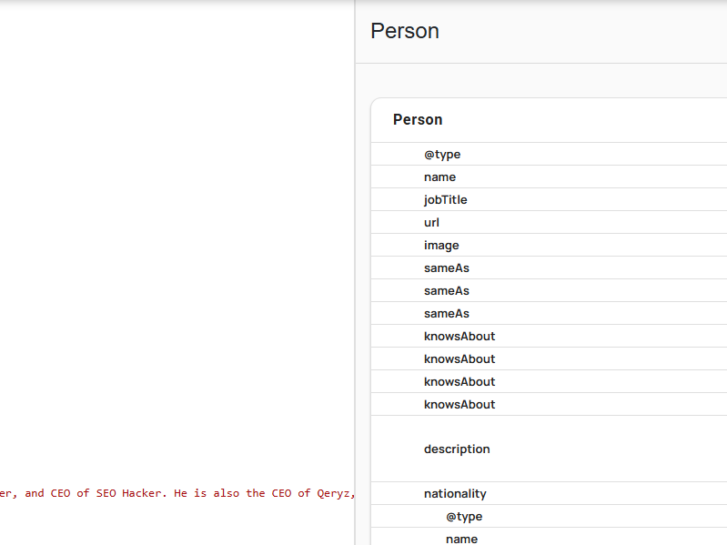How to Add Person Schema Markup to Strengthen Your Personal Brand Online
If you’re someone in the public eye—like an artist, author, speaker, founder, or expert—simply having a website isn’t enough. Search engines need to understand who you are, and they now place greater emphasis on Experience, Expertise, Authoritativeness, and Trustworthiness (E-E-A-T) when assessing both content and its creators. That’s where knowing how to add Person Schema comes in.
When implemented right, Person Schema can give your personal brand a real boost in search visibility. It helps trigger knowledge panels, rich snippets, and more accurate search results when people look you up. At the end of the day, it’s not just about ranking high. It’s about being recognized—and that’s what really moves the needle for personal branding.
What is Person Schema?
Person Schema is a structured data type from the Schema.org vocabulary designed to describe an individual in detail. It goes beyond simply stating a name by building a complete digital profile that traditional search, AI-powered search engines, and generative models can easily interpret. Think of it as a digital ID for a person, containing key information that helps search engines accurately understand and present who they are.
The main purpose of using Person Schema is to provide context. It connects a person’s name with their role, company, social profiles, areas of expertise, and other important details. With this structured data in place, search engines can display richer and more relevant results. AI Overviews, (and now AI Mode) can also draw from this information to generate precise and trustworthy summaries, enhancing visibility and strengthening a person’s online presence.
Where You Can Use Person Schema
The best place to add Person Schema is on any page that focuses on a specific individual. This could be:
- About Me pages – If you’ve got a page that talks about your background, achievements, and who you are, this is the perfect spot.
- Author bios – For writers and bloggers, this helps connect your articles to your profile and expertise.
- Team member profiles – On a company website, it’s a great idea to add Person Schema to each team member’s profile page, especially if they’re known in your industry.
- Speaker or presenter pages – If you speak at events or conferences, your profile page is a strong candidate.
- Public figure profiles – Whether you’re a politician, artist, or influencer, schema gives your profile more weight in search.
Just make sure the information in your schema matches what’s actually on the page. If there’s a mismatch, search engines might ignore the markup or flag it as an error. For companies, it’s also smart to link each Person Schema back to the main Organization Schema. This creates a clear, connected structure that helps search engines better understand your site and the people behind it.
Properties You Should Include in Your Person Schema Markup
| Property | Description | Required? |
| @context | Always set to “https://schema.org“ | Yes |
| @type | Always set to “Person” | Yes |
| name | Full name of the person | Yes |
| url | URL of the person’s official webpage or profile | Yes |
| image | A photo or avatar of the person (must be crawlable) | No, but recommended |
| jobTitle | The person’s job title or professional role | No, but recommended |
| worksFor | Organization or company the person is affiliated with | No, but recommended |
| alumniOf | The educational institution(s) the person graduated from | No, but recommended |
| sameAs | Links to the person’s verified social media or profile pages | No, but recommended |
| knowsAbout | Areas of expertise, topics the person is knowledgeable about | No, but recommended |
| description | A brief summary or bio describing the person | No, but recommended |
| nationality | Nationality of the person | No |
| birthDate | The person’s birth date (in ISO 8601 format: YYYY-MM-DD) | No |
| gender | Gender of the person | No |
| A contact email address (use mailto: format) | No | |
| telephone | A contact phone number | No |
| address | Structured postal address | No |
Bonus props if you’ve got details like birthDate, gender, contactPoint, or even award. Just make sure you’re not publishing anything the person wouldn’t want out there.
Keep it clean, honest, and valuable—for users and for Google.
How to Add Person Schema Markup
Adding Person schema markup to your site helps search engines better understand who you are and what you do. To keep things simple and effective, it’s best to use the JSON-LD format—clean, reliable, and recommended by Google.
Here’s the step-by-step guide to help you add it properly:
Step 1: Choose JSON-LD format
Go with JSON-LD for your schema markup—it’s Google’s recommended format. It keeps things clean and won’t interfere with your HTML code.
Step 2: Prepare your schema snippet
Wrap your JSON-LD code inside the <script type=”application/ld+json”> tag.
<script type=”application/ld+json”>
{
“@context”: “https://schema.org”,
“@type”: “Person”,
“name”: “Sean Si”,
“image”: “https://yourdomain.com/path-to-image.jpg”,
“jobTitle”: “CEO of SEO Hacker”,
“url”: “https://seo-hacker.com/”,
“nationality”: “Filipino”,
“sameAs”: [
“https://www.linkedin.com/in/seansi”,
“https://twitter.com/seansi”,
“https://www.facebook.com/seansi.fanpage”
],
“worksFor”: {
“@type”: “Organization”,
“name”: “SEO Hacker”,
“url”: “https://seo-hacker.com/”
},
“alumniOf”: {
“@type”: “EducationalOrganization”,
“name”: “De La Salle University”,
“sameAs”: “https://www.dlsu.edu.ph/”
},
“knowsAbout”: [
“Search Engine Optimization”,
“Digital Marketing”,
“Entrepreneurship”,
“Leadership”,
“Motivational Speaking”
],
“description”: “Sean Si is a Filipino entrepreneur, author, leadership speaker, and the CEO and founder of SEO Hacker. He also leads Qeryz, an online survey tool, and is known for writing and speaking on topics related to SEO, digital marketing, and personal growth.”
}
</script>
Step 3: Place it in the right location
Insert the script inside the <head> section of the specific page that features or describes the person (e.g., About Me or Author Bio page).
Step 4: Save and publish
Once added, save the changes and publish the page.
Author’s Note: If you’re finding my post, you might enjoy some of my other Schema Markup guides:
- How to Add Recipe Schema
- How to Add Product Review Schema
- How to Add LocalBusiness Schema
- How to Add Review Schema
- How to Add VideoObject Schema
I’ve written these to make structured data less intimidating and more actionable—especially if you’re doing SEO hands-on.
How to Validate Your Person Schema Markup
Once you’ve added your Person schema, don’t skip the last (but super important) step—test it.
You need to make sure your markup is clean, error-free, and actually doing what it’s supposed to do. Thankfully, Google and Schema.org give us awesome free tools for that:
- Rich Results Test – This is your go-to tool from Google. Plug in your page URL or paste your code, and it’ll show you any errors, warnings, and whether your schema is eligible for rich results like a Knowledge Panel. If it passes here, you’re on the right track.
- Schema Markup Validator – This one’s from Schema.org itself. It’s less about Google features and more about making sure your markup actually follows Schema.org standards. It catches stuff the Rich Results Test might not flag.
Use these tools regularly—especially after edits. Catching issues early means your structured data keeps doing what it’s meant to do: boost visibility and help search engines fully understand your personal brand.
Key Takeaway
In conclusion, using Person Schema Markup isn’t just some technical SEO trick—it’s a smart move for anyone serious about growing their online presence and making their personal brand more discoverable. It gives search engines the clarity they need to understand who you are, what you do, and why you matter.
It might feel a bit technical at first, but once you’ve got it set up right, it becomes a powerful signal that helps build trust, authority, and visibility across the web. In today’s digital world, where everyone’s fighting to stand out, Person schema helps you show up—not just as a name, but as a recognized and credible entity.


